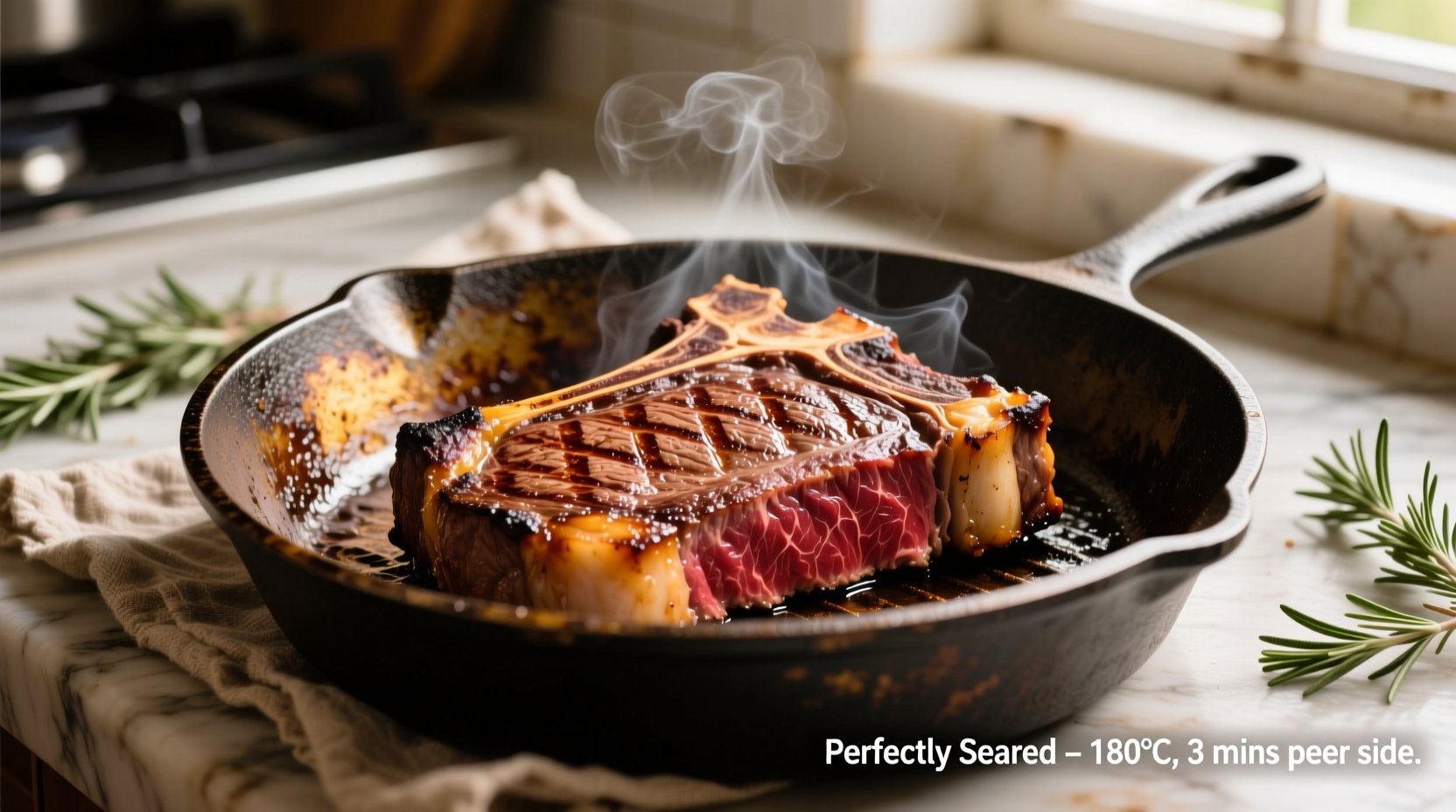Essential Equipment for Pan-Seared Steak Success
Start with the right tools. A heavy-bottomed cast iron or carbon steel frying pan delivers superior heat retention for that critical sear. Avoid non-stick pans which can't reach the high temperatures needed for proper Maillard reaction. You'll also need:
- Instant-read thermometer (USDA recommends this for food safety)
- Tongs with a flat gripping surface
- Heat-resistant spatula
- Metal basting spoon
Selecting Your Bone-In Steak
Not all cuts work equally well for pan cooking. Bone-in ribeye (also called cowboy steak) provides the best balance of marbling, flavor, and cooking properties for stovetop preparation. The bone insulates the meat, preventing overcooking near the bone while the surrounding meat reaches perfect doneness.
| Steak Cut | Recommended Thickness | Best Cooking Method |
|---|---|---|
| Bone-in Ribeye | 1.5 inches | Frying pan sear + oven finish |
| T-Bone/Porterhouse | 1.25 inches | Frying pan only |
| Strip Steak | 1.5 inches | Frying pan sear + oven finish |
Preparing Your Steak for Perfect Searing
Proper preparation makes the difference between good and great steak. Remove your steak from the refrigerator 60-90 minutes before cooking to bring it to room temperature. Pat the surface completely dry with paper towels - moisture is the enemy of proper searing. Season generously with coarse salt and freshly ground black pepper on all sides, including the edges.
The Pan-Searing Process: Step by Step
Heat your empty frying pan over medium-high heat for 5 minutes until properly preheated. Add 1 tablespoon of high-smoke point oil (avocado or grapeseed) and wait until it shimmers but doesn't smoke. Place the steak in the pan away from you to prevent oil splatter.
Let the steak cook undisturbed for 3-4 minutes to develop a proper crust. Resist the urge to move it - this allows the Maillard reaction to occur. After the initial sear, rotate the steak 90 degrees to create attractive cross-hatch marks, then cook for another minute.
Flip the steak and add aromatics: 2 tablespoons butter, 2 crushed garlic cloves, and fresh rosemary or thyme sprigs. Reduce heat to medium and continuously spoon the melted butter over the steak for 2-3 minutes. For thicker cuts (over 1.5 inches), finish in a 400°F oven until reaching desired internal temperature.
Temperature Guide for Perfect Doneness
According to USDA Food Safety and Inspection Service guidelines, steak should reach minimum internal temperatures for safety, though most steak enthusiasts prefer lower temperatures for optimal texture and flavor. Always use an instant-read thermometer for accuracy:
| Doneness | Internal Temperature | Texture Description |
|---|---|---|
| Rare | 120-125°F (49-52°C) | Cool red center, very soft |
| Medium Rare | 130-135°F (54-57°C) | Warm red center, tender |
| Medium | 140-145°F (60-63°C) | Warm pink center, slightly firm |
| Medium Well | 150-155°F (66-68°C) | Small amount of pink, firm |
| Well Done | 160+°F (71+°C) | No pink, very firm |

The Critical Resting Period
Never skip resting your steak. When you remove the steak from the pan, transfer it to a cutting board or warm plate and tent loosely with foil. Resting allows the muscle fibers to relax and redistribute juices throughout the meat. For a standard 1.5-inch thick bone-in steak, rest for 8-10 minutes. Thicker cuts require longer resting times - add 2 minutes per additional 0.5 inch of thickness. During this time, carryover cooking will raise the internal temperature by 5-10 degrees.
Avoid These Common Pan-Seared Steak Mistakes
Even experienced home cooks make these critical errors that compromise steak quality:
- Wet surface - failing to properly dry the steak prevents proper searing
- Overcrowded pan - lowers pan temperature and creates steam instead of sear
- Flipping too often - disrupts crust formation
- Cutting too soon - releases precious juices before they redistribute
- Ignoring carryover cooking - removes steak from heat too late, resulting in overcooking
Why Bone-In Makes a Difference
The bone isn't just for presentation. It serves as a natural insulator during cooking, creating a more even temperature gradient through the steak. The marrow and connective tissues near the bone also impart additional flavor as they render during cooking. Professional chefs often recommend scoring the fat cap and rendering it vertically in the pan for 2-3 minutes to maximize flavor development before searing the main surfaces.











 浙公网安备
33010002000092号
浙公网安备
33010002000092号 浙B2-20120091-4
浙B2-20120091-4